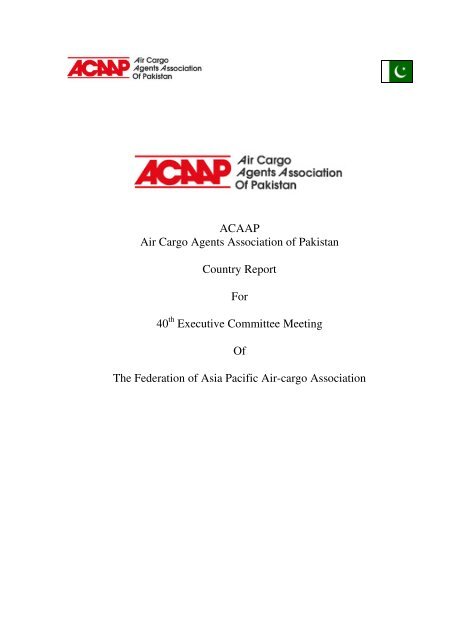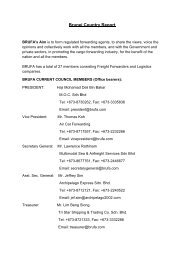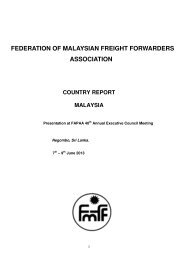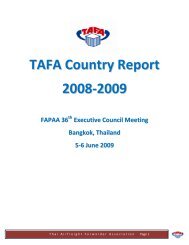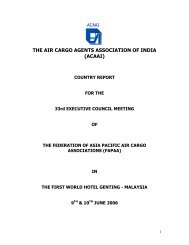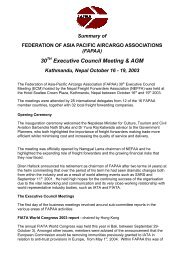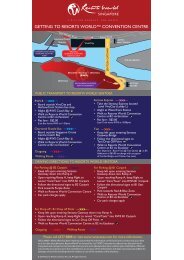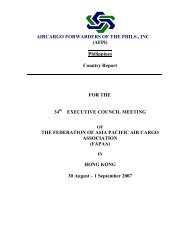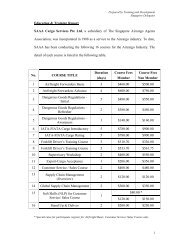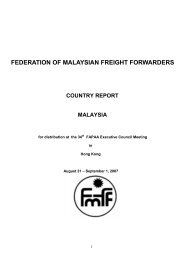ACAAP Air Cargo Agents Association of Pakistan Country ... - FAPAA
ACAAP Air Cargo Agents Association of Pakistan Country ... - FAPAA
ACAAP Air Cargo Agents Association of Pakistan Country ... - FAPAA
Create successful ePaper yourself
Turn your PDF publications into a flip-book with our unique Google optimized e-Paper software.
<strong>ACAAP</strong><strong>Air</strong> <strong>Cargo</strong> <strong>Agents</strong> <strong>Association</strong> <strong>of</strong> <strong>Pakistan</strong><strong>Country</strong> ReportFor40 th Executive Committee MeetingOfThe Federation <strong>of</strong> Asia Pacific <strong>Air</strong>-cargo <strong>Association</strong>
<strong>Air</strong> <strong>Cargo</strong> <strong>Agents</strong> <strong>Association</strong> <strong>of</strong> <strong>Pakistan</strong>Report <strong>of</strong> the Executive CommitteeFor the year 2012-2013ChairmanRegional Chairman ARegional Chairman BImmediate Past ChairmanMembers <strong>of</strong>Central Executive CommitteeMr. Muhammad Farrukh IqbalMr. Muhammad IlyasKhawaja Azhar SaeedMr. Tahir MalikSyed Musi RazaMr. Mansoor Shahid KashmirwalaMr. Asif NadeemMr. Rehanali RatnaniMr. Tariq HussainMr. Faraz Akram AwanMr. Mohammad Arif NadeemMr. Atif Rashid KhawajaHead Office<strong>Air</strong> <strong>Cargo</strong> <strong>Agents</strong> <strong>Association</strong> <strong>of</strong> <strong>Pakistan</strong>305, 3 rd Floor, Fortune Center45-A, Block-6, PECHS, Shahrah-e-FaisalKarachi-75400Telephone Nos: +92(21) 34383501 & 4527911Fax: +92(21) 34383502Email: chairman@acaap.org / Secretary@acaap.orgRegistered with the Ministry <strong>of</strong> Commerce, Government <strong>of</strong> <strong>Pakistan</strong>Lisence No.15
Economic resilience:<strong>Pakistan</strong>'s economy had, until a few years ago, beencharacterized as unstable and highly vulnerable toexternal and internal shocks. However, the economyproved to be unexpectedly resilient in the face <strong>of</strong>multiple adverse events concentrated.The Asian financial crisis; The global recession asevere drought, flood and earthquakes heightenedperceptions <strong>of</strong> risk as a result <strong>of</strong> military tensions withIndia – with as many as 1 million troops on the border, and predictions <strong>of</strong> impending (potentially nuclear)war; the post-9/11 military action in neighboring Afghanistan, with a massive influx <strong>of</strong> refugees andterrorists from that country; Despite these adverse events, <strong>Pakistan</strong>'s economy kept growing, andeconomic growth accelerated. This resilience has led to a change in perceptions <strong>of</strong> the economy, withleading international institutions such as the IMF, World Bank, and the ADB praising <strong>Pakistan</strong>'sperformance in the face <strong>of</strong> adversity.Macroeconomic reform and prospectsAccording to many sources, the <strong>Pakistan</strong>i government has madesubstantial economic reforms, and medium-term prospects for jobcreation and poverty reduction are the best in nearly a decade.Government revenues have greatly improved in recent years, as aresult <strong>of</strong> economic growth, tax reforms – with a broadening <strong>of</strong> thetax base, and more efficient tax collection as a result <strong>of</strong> selfassessmentschemes and corruption controls in the Central Board <strong>of</strong>Revenue – and the privatization <strong>of</strong> public utilities andtelecommunications. <strong>Pakistan</strong> is aggressively cutting tariffs andassisting exports by improving ports, roads, electricity supplies andirrigation projects. Islamabad has doubled development spendingfrom about 2% <strong>of</strong> GDP to 4%, a necessary step towards reversing thebroad underdevelopment <strong>of</strong> its social sector.Liberalization in the international textile trade has already yielded benefits for <strong>Pakistan</strong>'s exports, and thecountry also expects to pr<strong>of</strong>it from freer trade in agriculture. As a large country, <strong>Pakistan</strong> hopes to takeadvantage <strong>of</strong> significant economies <strong>of</strong> scale. These industries play to <strong>Pakistan</strong>'s relative strengths in lowlabor costs.Growing stability in the nation's monetary policies has contributed to a reduction in money-marketinterest rates, and a great expansion in the quantity <strong>of</strong> credit, changing consumption and investmentpatterns in the nation. <strong>Pakistan</strong>'s domestic natural gas production, and its significant use <strong>of</strong> CNG inautomobiles, has cushioned the effect <strong>of</strong> the oil-price shock. <strong>Pakistan</strong> is also moving away from thedoctrine <strong>of</strong> import substitution which some developing countries, dogmatically pursued in the twentiethcentury. The <strong>Pakistan</strong>i government is now pursuing an export-driven model <strong>of</strong> economic growthsuccessfully implemented by South East Asia.In 2005, the World Bank reported that "<strong>Pakistan</strong> was the top reformer in the region and the number 10reformer globally – making it easier to start a business, reducing the cost to register property, increasingpenalties for violating corporate governance rules, and replacing a requirement to license every shipmentwith two-year duration licenses for traders”
Doing BusinessThe World Bank (WB) and International Finance Corporation's flagship report <strong>Pakistan</strong> 85among 181 countries around the globe. <strong>Pakistan</strong> comes highest in South Asia but also rankshigher than China and Russia which is at 133. The top five countries are Singapore, NewZealand, the United States, Hong Kong and United Kingdom.The Government <strong>of</strong> <strong>Pakistan</strong> has granted numerous incentives to technology companies wishingto do business in <strong>Pakistan</strong>. A combination <strong>of</strong> decade-plus tax holidays, zero duties on computerimports, government incentives for venture capital and a variety <strong>of</strong> programs for subsidizingtechnical education, are intended there.The economy todayDue to inflation and economic crisis worldwide, <strong>Pakistan</strong>'s economy reached a state <strong>of</strong> Balance <strong>of</strong>Payment crisis. <strong>Pakistan</strong> experienced a period <strong>of</strong> tremendous growth, averaging 7% yearly GDP growth,Due to its large population <strong>of</strong> 186 million, it was included by the Goldman Sachs Global EconomicsGroup as one <strong>of</strong> the "Next Eleven (N-11)" – a group <strong>of</strong> countries with economies that “might have thekind <strong>of</strong> potential for global impact that the BRICs projections highlighted, essentially an ability to matchthe G7 in size” Since the beginning <strong>of</strong> 2008, <strong>Pakistan</strong>'s economic outlook has taken stagnation. Securityconcerns stemming from the nation's role in the War on Terror have created great instability and led to adecline in FDI. Concurrently, the insurgency has forced massive capital flight from <strong>Pakistan</strong> to the Gulf.Combined with high global commodity prices, the dual impact has shocked <strong>Pakistan</strong>'s economy, withgaping trade deficits, high inflation and a crash in the value <strong>of</strong> the Rupee, for the first time in years; itmay have to seek external funding as Balance <strong>of</strong> Payments support. Consequently, S&P lowered<strong>Pakistan</strong>’s foreign currency debt rating to CCC-plus from B, just several notches above a level that wouldindicate default. <strong>Pakistan</strong>’s local currency debt rating was lowered to B-minus from BB-minus. Creditagency Moody’s Investors Service cut its outlook on <strong>Pakistan</strong>’s debt to negative from stable due topolitical uncertainty, though it maintained the country’s rating at B2.The cost <strong>of</strong> protection against adefault in <strong>Pakistan</strong>’s sovereign debt trades at 1,800 basis points, according to its five-year credit defaultswap, a level that indicates investors believe the country is already in or will soon be in default.Economic comparison <strong>of</strong> <strong>Pakistan</strong> - Foreign Trade (<strong>Pakistan</strong>i exports)<strong>Pakistan</strong> is a member <strong>of</strong> the World Trade Organization, and has bilateral andmultilateral trade agreements with many nations and internationalorganizations.Fluctuating world demand for its exports, domestic political uncertainty, andthe impact <strong>of</strong> occasional droughts as well flood on its agricultural productionhave all contributed to variability in <strong>Pakistan</strong>'s trade deficit.<strong>Pakistan</strong>'s exports continue to be dominated by cotton textilesand apparel, despite government diversification efforts. Majorimports include petroleum and petroleum products, edible oil,chemicals, fertilizer, capital goods, industrial raw materials, andconsumer products.<strong>Pakistan</strong>'s hard currency reserves have grown. Improved fiscal management,greater transparency and other governance reforms have led to upgrades in<strong>Pakistan</strong>'s credit rating. Together with lower global interest rates, these factors
have enabled <strong>Pakistan</strong> to prepay, refinance and reschedule its debts to its advantage.The EU is the single largest trading partner <strong>of</strong> <strong>Pakistan</strong> absorbing overone-third <strong>of</strong> the exports. The EU accounted for 12.4% <strong>of</strong> <strong>Pakistan</strong>iimports and 22.6% <strong>of</strong> its exports.Exports:<strong>Pakistan</strong> exports rice, oranges, mangoes,furniture, cotton fiber, cement, tiles, marble, textiles,clothing, leather goods, sports goods (renowned forfootballs/soccer balls), cutlery, surgical instruments, electrical appliances,s<strong>of</strong>tware, carpets and rugs, ice cream, livestock meat, chicken, powdered milk, wheat,seafood (especially shrimp/prawns), vegetables, processed food items, <strong>Pakistan</strong>iassembledSuzuki (to Afghanistan and other countries),defense equipment (submarines,tanks, radars), salt, onyx, engineering goods, and many other items. <strong>Pakistan</strong> producesand exports cements to Asia and the Middle East. In August 2007, <strong>Pakistan</strong> startedexporting cement to India to fill in the shortage there caused by the buildingboom. [83] Russia is a growing market for <strong>Pakistan</strong>i exporters.Since the beginning <strong>of</strong> 2008, <strong>Pakistan</strong>'s economic outlook has taken a dramatic downturn. Securityconcerns stemming from the nation's role in the War on Terror have created great instability and led to adecline in FDI. Concurrently, the insurgency has forced massive capital flight from <strong>Pakistan</strong> to the Gulf.Combined with high global commodity prices, the dual impact has shocked <strong>Pakistan</strong>'s economy, withgaping trade deficits, high inflation and a crash in the value <strong>of</strong> the Rupee, which has fallen in a fewmonths; it may have to seek external funding as Balance <strong>of</strong> Payments support. Consequently, the EIU hadestimated that inflation should drop back to single digits, and that growth would pick up to over 5% perannum soon. However, the unprecedented floods which encapsulated 20% <strong>of</strong> <strong>Pakistan</strong>'s land area havecaused a monetary damage estimated to be in excess <strong>of</strong> $10bn, as a result <strong>of</strong> which real growth is almostflat and EIU's original targets will have to be revised. Much like previous natural disasters which haveafflicted <strong>Pakistan</strong>, the floods <strong>of</strong> 2010 inflicted damage <strong>of</strong> epic proportions. However, the philanthropicnature <strong>of</strong> <strong>Pakistan</strong>i people and widespread coverage by a fiercely independent and established media hasproven yet again that <strong>Pakistan</strong> is an incredibly resilient nation.Aviation IndustryTransportation sector is most important sector <strong>of</strong> any economy and aviation industry is major part <strong>of</strong> thissector. In <strong>Pakistan</strong> the transportation and communication sector holds more than 10% share in GDP(Gross Domestic Production). The aviation industry can affect the other sector <strong>of</strong> the economy, e.g. theInternational Trade, tourism and socio-economic condition <strong>of</strong> the country.Historically <strong>Pakistan</strong> International <strong>Air</strong>line dominates the major portion <strong>of</strong> aviation industry. The stateowned PIAC conduct the domestic as well international operations.<strong>Pakistan</strong> Logistics is focused at state <strong>of</strong> the art technology and solutions for the logistics sector. Emergingtechnologies in the transportation & allied sectors and aims to focus on the immense potential <strong>of</strong> thetransportation modes and related services to cater to the domestic and international demand, the newmarkets, trends and innovations in the international transport and logistics industry and in general theopportunities for the region in particular.Competition in Open Blue Skies
Civil aviation Authority has opened the aviation sector for private investor in order to boost the healthycompetition for better traveling services at low price fares. As a result many private companies makeinduction in to industry.Private companies, <strong>Air</strong> Blue, Shaheen <strong>Air</strong> and Royal <strong>Air</strong>lines, besides PIA is operating on internationalroutes. The Gulf sector is another important and lucrative sector for airlines. The European especially U.Kand North American destination are pr<strong>of</strong>it making routes, PIA has made Investment <strong>of</strong> billion <strong>of</strong> rupeesfor acquiring the state <strong>of</strong> the art aircrafts for operations in north American sectors. International routes aremajor area <strong>of</strong> competition for up coming airlines. The CAA policy regarding the international routes arevery open but require the minimum standards to be met before operating on international routes and musthave experienceOf domestic operations before going to be international.The <strong>Air</strong>Blue has the share <strong>of</strong> domestic routes mainly the Karachi-Lahore-Islamabad sector. While Royal<strong>Air</strong>line is operating cargo flights and successfully operates on Karachi-Dubai sector.Royal <strong>Air</strong>line is chain <strong>of</strong> international airlines and has been registered in <strong>Pakistan</strong>. It has acquired thelicense for cargo transportation and has planned to conduct domestic operations for passengers also.<strong>Air</strong> Blue has conducted the operation on Karachi-Lahore-Islamabad sector and is in stage <strong>of</strong> capturing thedomestic market by <strong>of</strong>fering compatible faresDiscounts are <strong>of</strong>fered on early booking and the E-ticketing is introduced in <strong>Pakistan</strong>.The major focus is on customer comfort, trained employee, maximum customer satisfaction.Another land mark is innovative e-ticketing technology, through web base technology customer can makereservation on-line 24 hours a days and 7 Days a week. The convenience <strong>of</strong> air travel reservation by newsystem will enhance the customer satisfaction, and new innovative technologies would encourage otheroperators to introduce similar technologies for its survival in the market.Quality ServicePIA <strong>Cargo</strong> commenced operations in 1974, with flights to the USA, Europe,and Hong Kong on the B-707 aircraft. PIA <strong>Cargo</strong> has the unique distinction<strong>of</strong> introducing <strong>Pakistan</strong>'s fruits to international markets and pioneered theexports <strong>of</strong> fresh fruits and vegetables to global destinations. Operating as theair freight division <strong>of</strong> <strong>Pakistan</strong>'s national carrier, PIA <strong>Cargo</strong> has achievedrapid growth and reaches out to destinations spanning the globe through itspassenger scheduled flights and freighter services.PIA <strong>Cargo</strong> earns valuable revenue for <strong>Pakistan</strong> International <strong>Air</strong>lines and provides a massive boost to<strong>Pakistan</strong>'s wide spectrum <strong>of</strong> exports. The aggressive growth <strong>of</strong> PIA <strong>Cargo</strong> coupled with PIA's rapidlyexpanding passenger operations empowers customers with a range <strong>of</strong> cutting-edge cargo products andservices. In addition to <strong>of</strong>fering cargo services, PIA <strong>Cargo</strong> also arranges charter flights to lift meat,livestock and relief goods within and outside <strong>Pakistan</strong>.A range <strong>of</strong> commodities across <strong>Pakistan</strong> as well as a growing list <strong>of</strong> global destinations. The commoditiesthat PIA <strong>Cargo</strong> ships run the gamut from edibles such as meat and vegetables, to textiles, paper products,laboratory equipment, and even un-cremated human remains. PIA <strong>Cargo</strong> also specializes in the uplift <strong>of</strong>
special cargo such as relief goods, live animals (sheep, cows, camels, horses), and shipments for cargoaircraft. These commodities are uplifted on leased freighters as and when the need arises.Up Coming ScenarioRecently many developments have been taken place, India has open the air corridor for <strong>Pakistan</strong>i airline,development <strong>of</strong> new port like Gawadar & Sialkot the rising cost <strong>of</strong> fuel and heavy taxes <strong>of</strong> CAA. In allthese threats and opportunities the new and existing airline are going to operate and compete with eachother not solely on price base but on the basis <strong>of</strong> services standardsThings, however, have started to pick up, the PIA has started operation to India and Far East, and theforeign carriers who closed their <strong>Pakistan</strong> operations are back. Now the question arises that how newairlines would captured the market, before airlines were sharing domestic market among themselves. PIAwere dominating the market by 75% and rest were enjoyed by other private airlines, in prevailingconditions the new entrance would either gain the share from currently operating airlines or create newcustomer base or combination <strong>of</strong> both. Let’s see how they survive in cut throat competition.Growth and InvestmentEconomic Survey public administration & defence, and social services, contributed lion’s share <strong>of</strong> thismodest growth rate. Gross fixed investment declined substantially, from 22.5 percent <strong>of</strong> GDP to 13.4percent. More importantly the private sector witnessed a significant fall and recorded lowest ratio, thisimplies a significant deterioration in the job creating ability <strong>of</strong> the economy. While the economicenvironment in <strong>Pakistan</strong> remained in hospitable for growth and investment, a comprehensive growthstrategy is being evolved, to increase productivity, efficiency, and competitiveness <strong>of</strong> the economy, and toensure high growth rates that are both sustainable as well as more equitable. In addition, and equallyfundamentally, a pivotal element <strong>of</strong> the stabilization program included putting in place direct incomesupport measures to protect the poor and vulnerable sections <strong>of</strong> the population through BISP. Thegovernment is now expanding the social safety net to a broader platform <strong>of</strong> social development, the scale<strong>of</strong> which is unprecedented in <strong>Pakistan</strong>’s history. Despite negative effects on the economy <strong>of</strong> a host <strong>of</strong>challenges, especially with regard to growth, when viewed in the global context, <strong>Pakistan</strong>’s economicperformance has not been out <strong>of</strong> sync with its peers.Role <strong>of</strong> Logistics in Trade Promotion with reference to <strong>Pakistan</strong>In today’s globalized world, whether a country is able to move goods quickly cost effectively and reliablyacross borders largely determines its degree <strong>of</strong> inclusion in the global markets as trade logistics facilitatetrade. Trade logistics plays a very important role in the volume and value <strong>of</strong> international trade and poorquality logistics is a key barrier to trade. High quality logistics services improve the competitiveness <strong>of</strong> acountry’s exports by reducing the cost involved in transporting goods. Across the board, elements <strong>of</strong> tradelogistics, such as customs procedures, tracking and tracing services, overall infrastructure and logisticscompetence impact trade relatively more than less policy-dependent trade determinants such as distanceand transport costs.Transport which is one <strong>of</strong> the most expensive components <strong>of</strong> Trade Logistics, an adequate infrastructureis crucial to facilitate transportation. According to <strong>Pakistan</strong> Infrastructure Implementation CapacityAssessment, the transport sector inefficiencies are costing economy between 4 to 5% <strong>of</strong> GDP (Rs. 500 b)each year indicating the need for massive investment in Road, Rail, <strong>Air</strong> and Sea Ports. Our ranking ininfrastructure under Logistics Performance Index is 120 which is even lower than our overall ranking.Another significant component <strong>of</strong> logistics services is a well developed information system. Informationflows may be electronic, paper-based or voice based. If economies, and in particular, developingeconomies, are to participate fully in global production and supply <strong>of</strong> intermediate and finished goods,
their ability to do so will be affected by the standards <strong>of</strong> their Information and Communication.Technology infrastructure is an important component <strong>of</strong> trade and transport facilitation. Our state <strong>of</strong> theart information technology system at the ports helps in tracking the shipments all through arrival tilldeparture, however there is a paramount need for a tracking system to be in place during thetransportation which is the one <strong>of</strong> the most time consuming elements. Furthermore, indirect costs such astime delays in shipping can take several forms but ultimately they increase the cost to firms that are thenpassed on to consumers. Lower shipping times are associated with higher volumes <strong>of</strong> trade. Findings <strong>of</strong> arecent research carried out indicated that every extra day needed to ready goods for import or export mayreduce trade by around 4%. The recent shift from PACCS to WEBOC has intensified the proceduresthereby increasing time to get customs release eventually causing delays in exporting/importing thecargoes. Having talked about the role <strong>of</strong> logistics in Trade and the situation prevailing in the country, Iwould now like to highlight a few recent opportunities arose that, if tapped well, are likely to open manydoors for our industry, a few challenges being faced and related recommendations.Talking about the opportunities, Government <strong>of</strong> <strong>Pakistan</strong>’s recent emphasis on PublicPrivate Partnership Program includes Transport and Logistics as one <strong>of</strong> the major areas to be worked onas investment in this area would certainly enhance trade. We request theGovernment to take this forward on priority basis and involve private sector extensively in the project asthis is need <strong>of</strong> the hour.The recent emphasis <strong>of</strong> our Government on 'Trade not Aid' is likely to open markets for<strong>Pakistan</strong>i products to foreign markets. This implies a huge opportunity as successful trade has to bebacked up by strong logistics and urges public and private sectors to look into enhancing logisticscompetency to another level.The recently signed Agreement on Trade in Services by SAARC members is expected to open manydoors not only to facilitate trade among the members countries but the development <strong>of</strong> infrastructure withspecial emphasis on intra regional connectivity through the construction <strong>of</strong> road, rail and air networks.Government’s strategy <strong>of</strong> improving Bilateral Trade with neighboring countries would be a greatopportunity that would not only reduce the trade logistics cost but also decrease the risk element involvedin the transport <strong>of</strong> perishable cargo due to shorter transit.Now to the challenges and related recommendations, The biggest challenge, I believe, is the provision <strong>of</strong>electricity and gas supply to the industry which is not only paralyzing the entire industry but is also themain hurdle in managing the cold chain logistics that causes huge production losses.<strong>Pakistan</strong> looses an estimated 40% <strong>of</strong> its production <strong>of</strong> fruits, vegetables and dairy products due to the lack<strong>of</strong> an adequate cold supply chain, according to figures released by the Punjab Board <strong>of</strong> Investment andTrade. <strong>Pakistan</strong> gets, on average, only 41% <strong>of</strong> the international price on its food exports owing to weakcold chains in the country.Limited capacity <strong>of</strong> ports with regard to space becomes a huge challenge due to the unstable politicalsituations. A couple <strong>of</strong> days <strong>of</strong> strike causes huge blockage at the ports resulting in vehicles getting stuckin Karachi and hugely disturbing the import and export logistics flow. There is a paramount need toincrease capacities <strong>of</strong> our ports.The road infrastructure is to be enhanced with immediate effect in order to ensure smoothTransportation.The fifth challenge pertains to the limited options for inland movement. The domestic railinfrastructure is to be worked on extensively in order for the exporters/importers to have
Multiple options for inland movement. Having various multi model facilities is an important aspect <strong>of</strong> theTransport infrastructure <strong>of</strong> a country.To conclude, the growth in Trade and Logistics are directly proportional to each other. Investments inlogistic services and infrastructure can highly enhance trade. In addition it can also guide as to whichinfrastructure investments are likely to bring larger gains.This will benefit countries the most. This brings me to another important aspect which is promotingpolicies to continue to move trade facilitation reforms forward. This reflects the need <strong>of</strong> having a separateLogistics Ministry on Board to address all these issues with regular participation and support from thePrivate Sector through Public Private Partnership Program.<strong>Pakistan</strong> is one <strong>of</strong> the finest producers <strong>of</strong> cotton, rice, wheat, sugar, various fruits and vegetables and hasadequate resources to transform the raw materials to finished product; the only need is to bring aboutsynergy among the Trade and Logistics for which a platform is needed in the shape <strong>of</strong> a separate ministryto address all the challenges.Freight Forwarder & Shipping IndustryThere are some various facilities which freight forwarder <strong>of</strong>fers to exporters than they prefer and moveshipment through freight forwarders. The freight forwarders provide Pin to point service, Best possiblefreight rate, Nominated cargo, transportation at POL and POD, Maximum Credit days, Consolidation &De-consolidation cargo, Check and balance system, custom clearance and Procurement Managementthrough all above facility they grape the position in shipping industry and play a major role between theshipping line and exporters.Data Analysis <strong>of</strong> Pin to point service (Door to door delivery):According to all responded the freight forwarder have capable to provide Pin to Point service from thepoint <strong>of</strong> production to point <strong>of</strong> consignee warehouse or directly to retail store. They arrange thetransportation from the exporter ware house to the terminal at port <strong>of</strong> origin and <strong>of</strong>fer clearing agent forthe custom purpose and also at point <strong>of</strong> destination they do issue the cargo from shipping line, clear theclearance to custom at the POD and delivered the cargo to consignee door or ware house if the customerrequired and also they entertain their customer when the cargo on board. Freight Forwarders continuouslytracking the cargo and inform to their customer according. As Freight Forwarder have advantage toprovide pin to point service provider and the shipping line have disadvantage they are enable to providepin to point service.The final conclusion are the Freight Forwarder provide reliable , fast and quality base service, FCL andLCL freight, door-to-door service and special assignments and project to exporters.Data Analysis <strong>of</strong> best possible Freight rate <strong>of</strong>fer to exporters: Currently the exporters required to bestpossible freight rate for their shipment so the question is that who gives best freight rate whether shippingline or freight forwarder. According to RF1 and RS3 normally the larges exporters do business withdirectly to the shipping line, they don't do business with Freight forwarder until or unless their buyer arenot required to use specific Freight forwarder, large exporters give the cargo to the shipping line instead<strong>of</strong> Freight Forwarders b/c they cannot <strong>of</strong>fer best freight rate which shipping line <strong>of</strong>fer to large exporters..According to RS4 basically the larges exporters have contribute with the large number <strong>of</strong> volume onweekly basis in shipping line they have lots <strong>of</strong> cargo per week so the shipping line have grab the volumethrough <strong>of</strong>fer the cheap freight to large exporters. That's why larges exporters always choose to dobusiness with direct shipping line until or unless their buyer are not bound to specific freight forwarders.The shipping line always gives high freight rate to freight forwarders as compare to larges exporters b/c
the shipping line understand that the cargo which freight forwarder have now from, its possibility to thatparticular cargo will go another shipping line that business are not secure.According to all responded, the exporters who small or medium exporters. They have normal or lowvelum base cargo per week and also they don't have healthy financial position so they prefer to dobusiness on maximum credit basis instead <strong>of</strong> cash. Normally shipping lines are <strong>of</strong>fer maximum creditdays for that exporter because the possibility <strong>of</strong> risk are very high that's why the shipping line <strong>of</strong>fer highfreight <strong>of</strong> those exporters and no give any credit days only doing business on the basis <strong>of</strong> cash. Theshipping line avoid do handle directly on those exporters.According to RF1 and RF2 the freight forwarder clubs all cargo which comes from the different small andmedium exporters and <strong>of</strong>fers the competitive freight rate accordingly. Freight forwarders takescompetitive freight rate from shipping line on the basis <strong>of</strong> large volume and grab the exporter's market.That's why Freight forwarder target to all small and medium exporters and generate the heavy volume .Inexporter's side this is one <strong>of</strong> the best advantage to use <strong>of</strong> Freight forwarder because small and mediumexporters are enable to take best freight rate from the shipper due to low velum but through Freightforwarder they will enjoy the competitive freight and service. Freight forwarders are entertained to allsmall and medium exporters who have exit e.g. doing business in a bang low or factory. FreightForwarder <strong>of</strong>fer rate high but also <strong>of</strong>fer transportation and credit facility (Maximum days), if exporterrequired custom clearance then also provide.The final conclusion are the some various facility which Freight Forwarder <strong>of</strong>fer to exporters, basically allexporter required best possible freight with efficient services at point <strong>of</strong> origin and point <strong>of</strong> destinationwhich Freight Forwarder are able to full feel accordingly and grab the exporter's market.Data Analysis <strong>of</strong> Nomination shipments:According to all responded when the buyer required to control the supply chains management at point <strong>of</strong>origin where shipper are manufacturing goods so the buyer have maintain own supply chain managementthere. They bound to exporter's to use specific shipping line and freight forwarder and also buyer keep incontact to that specific freight forwarder, some time they said to freight forwarder to manage theProcurement, these type shipment always basis on FOB (Collect).According to RF1 & RS3 basically nominated cargos started control <strong>of</strong> SCM because to local supplierunable to match shipment dates so the participant <strong>of</strong> SCM involve and monitor supplier's productionaccording the consignee requirement so there after involvement <strong>of</strong> SCM they are able to control them.Initially the nominated cargo business were not controlled but when the exporter have starting the somedispute regarding the shipment delay, packing ,quality and quantity <strong>of</strong> the cargo ,also the Freightforwarder issue back dated House bill <strong>of</strong> lading on request <strong>of</strong> exporters. so the exporters have taken anadvantage <strong>of</strong> this and do some miss commitment to buyer then the buyer are most conscious and start theNominated shipment and control SCM.The final conclusion that the big buyer or consignee depend very much to the SCM and they maintainSCM through freight forwarders, the exporters must follow SCM other wise some time the buyer orconsignee claim or cancel the shipment at the last movement. Some time buyer place orders to supplierwith small activity so the freight forwarders club the all small supplier cargo and stuff / load into onecontainer as per buyer instruction. These SCM also provide the inspection service at the supplier warehouse if the buyer is required. All above condition are very to the requirement <strong>of</strong> buyer if buyer requiredto freight forwarder's agent go to exporters ware house at the time <strong>of</strong> stuffing <strong>of</strong> cargo or while they aremanufacturing the shipment then their agent go. It depends all about the need <strong>of</strong> buyer. This is likely todoing for larges buyer.
The following causes are which we discuss above, the buyer prefer to nominated cargo and the other handfreight forwarder have also earned good pr<strong>of</strong>it and in USA 90% shipment through freight forwarderbecause there are most <strong>of</strong> discrepancy come if they do direct to exporters and according to nominatedcargo it is reduce the risk <strong>of</strong> payment, this type <strong>of</strong> shipment are very favorable for the freight forwarderand shipping line.Data Analysis <strong>of</strong> Transportation facilities:According to RS3 & RS4 the shipping line never <strong>of</strong>fer transportation at point <strong>of</strong> origin exporter factory toterminal and point <strong>of</strong> destination to buyer ware house or retail store, this is one <strong>of</strong> disadvantage <strong>of</strong>shipping line and the freight forwarder take an advantage through <strong>of</strong>fer the transportation to the exportersto buyer or retail store.The final conclusion that a strong freight forwarding industry is imperative if the country is to capitalizeon emerging opportunities as well as enhancing the efficiency <strong>of</strong> valuable industries. The increasingcomplexity <strong>of</strong> global trade practices comprising multi-modal transportation, cargo consolidation atregional hubs, distribution at destinations and multiple documentation have increased the importance <strong>of</strong>freight forwarder (intermediaries providing logistics) solutions.Data analysis <strong>of</strong> credit day's facility: According to RF1 & RF2 normally freight forwarders gives 15 to 45days credit days to all exporters and 45-to 60 to large exporters but they always cross the credit days thanthey paid. The shipping line <strong>of</strong>fer only 12 to 15 credit days to exporters and freight forwarders. FreightForwarder have high risk for payment side from small exporters but due to maximum credit days theexporters are interested to do business with them because the shipping line never <strong>of</strong>fer to credit days forall exporters only <strong>of</strong>fer to large exporters for 12 to 15 days.The final conclusion that the credit days are also main tools <strong>of</strong> the freight forwarders to grab the exportersand directly impact to the shipping lines. The shipping line avoids <strong>of</strong>fering credit days for small andmedium exports.Data analysis <strong>of</strong> Consolidation and De- consolidation cargo: The second positive tools <strong>of</strong> freightforwarders that they target to small industrial customers those have small cargo not equal to full containerso the freight forwarders are making one container to club the all small cargo and also charge fee on thebasis <strong>of</strong> cargo volume not full <strong>of</strong> container at point <strong>of</strong> origin and also the same facility provide at point <strong>of</strong>destination and distribute the cargo according to their buyer, this process called consolidation and deconsolidation<strong>of</strong> cargo.Basically consolidation shipment mean the one container have stuff goods with the two or more exportersand de-consolidation mean that consolidate container de-stuff at port <strong>of</strong> discharges accordingly anddeliver to the actual buyer ware house or door. The small exporter are required to consolidated cargobecause they don't have large volume to export and due to small cargo they can't book the one container<strong>of</strong> particular shipment so they go to freight forwarder who provide fast, reliable and cost effective service<strong>of</strong> consolidation and de-consolidation shipment from <strong>Pakistan</strong> to around the global.Check and Balance System (Buyer feel comfortable): According to RFI, RF2 normally the larges buyer,departmental store e.g. World Mart, IKEA, who do trade all over the global they manage supply chainmanagement at point <strong>of</strong> manufacturing place where the goods produces so through supply chainmanagement the buyer are full satisfy the quality <strong>of</strong> goods but in this process can't complete without theinvolvement <strong>of</strong> freight forwarder because these activity can perform and control by freight forwarderbecause shipping line never do, so on the basis <strong>of</strong> check and balance system freight forwarder take anadvantage and grab the market <strong>of</strong> exporter's and highly involve is this trade.
<strong>Air</strong> <strong>Cargo</strong> <strong>Agents</strong> <strong>Association</strong> <strong>of</strong> <strong>Pakistan</strong>(<strong>ACAAP</strong>)<strong>Air</strong> <strong>Cargo</strong> <strong>Agents</strong> <strong>Association</strong> <strong>of</strong> <strong>Pakistan</strong> (<strong>ACAAP</strong>), the only Government Registered National<strong>Association</strong> <strong>of</strong> <strong>Air</strong> <strong>Cargo</strong> <strong>Agents</strong>/ <strong>Air</strong> Freight Forwarders throughout <strong>Pakistan</strong>.<strong>ACAAP</strong> was formed in 1984 and was registered with the Ministry <strong>of</strong> Commerce Government <strong>of</strong> <strong>Pakistan</strong>in 1993 and was reregistered in 2007 as per the rules <strong>of</strong> Trade Organizations Ordinance 2007 bearinglicense no.15.The National <strong>Association</strong> <strong>ACAAP</strong> has its own identity; <strong>ACAAP</strong> has two regions all over <strong>Pakistan</strong>.Region “A” and Region “B”.Region “A” consist <strong>of</strong> provinces <strong>of</strong> Sindh and Baluchistan while Region “B” consist <strong>of</strong> Punjab andKhaiber Pakhtoon Khwa formerly known as NWFPHead <strong>of</strong>fice <strong>of</strong> <strong>ACAAP</strong> is situated at Karachi while in Region “B” it has its Regional <strong>of</strong>fice at Lahore anda Zonal <strong>of</strong>fice at Sialkot.The Secretary General looks after the affairs <strong>of</strong> <strong>ACAAP</strong> at Head Office, Karachi while Regional andZonal Secretaries are responsible for Regional and Zonal affairs in coordination with Head Office.REGISTRATION OF <strong>ACAAP</strong>A team <strong>of</strong> dedicated senior <strong>Cargo</strong> <strong>Agents</strong> invited all <strong>Air</strong> <strong>Cargo</strong> <strong>Agents</strong> throughout the country to obtainmembership so that interest <strong>of</strong> <strong>Air</strong> <strong>Cargo</strong> Industry could be looked properly.Each year elections <strong>of</strong> <strong>ACAAP</strong> are held on all <strong>Pakistan</strong> basis for the selection <strong>of</strong> Chairman for a period <strong>of</strong>one year and CEC members for a period <strong>of</strong> 2 years. CentralChairman<strong>ACAAP</strong>RegionalChairmanRegion‘A’RegionalChairmanRegion‘B’<strong>Air</strong>CECMember1CECMember2CECMember3CECMember4CECMember5CECMember6CECMember7CECMember8CECMember9CECMember10CECMember11CECMember12<strong>Cargo</strong> <strong>Agents</strong> <strong>Association</strong> <strong>of</strong> <strong>Pakistan</strong> (<strong>ACAAP</strong>) is a Sole Representative Body <strong>of</strong> IATA <strong>Air</strong> <strong>Cargo</strong><strong>Agents</strong> who are providing services to Shippers (Exporters) all over <strong>Pakistan</strong>.
Being totally pr<strong>of</strong>essional body, the main objective and vision <strong>of</strong> <strong>ACAAP</strong> is to promote and developinfrastructure to develop <strong>Air</strong> <strong>Cargo</strong> Industry in <strong>Pakistan</strong> and safeguard the rights and privileges <strong>of</strong> IATA<strong>Air</strong> <strong>Cargo</strong> <strong>Agents</strong> in general and specially its Members.To achieve the objective, <strong>Air</strong> <strong>Cargo</strong> <strong>Agents</strong> <strong>Association</strong> <strong>of</strong> <strong>Pakistan</strong> has already taken up variousinitiatives and striving hard to ensure better services to our Members.To establish the high ethical standards among specified constituents <strong>of</strong> the <strong>Air</strong> <strong>Cargo</strong> Trade.To arrange for and encourage the training <strong>of</strong> technical personals when practicable in the interest <strong>of</strong> <strong>Cargo</strong>Industry.BRIEF ACTIVITIES<strong>ACAAP</strong> due to its role have assumed importance and enjoys respect from all <strong>Air</strong>lines and variousgovernment agencies like the Customs, Civil Aviation Authority, and Trade Development Authority <strong>of</strong><strong>Pakistan</strong> etc. <strong>Air</strong> <strong>Cargo</strong> <strong>Agents</strong> <strong>Association</strong> <strong>of</strong> <strong>Pakistan</strong> (<strong>ACAAP</strong>) plays active part in development <strong>of</strong> <strong>Air</strong><strong>Cargo</strong> Industry.<strong>ACAAP</strong> takes all steps which are necessary for initiating or promoting any action which is likely to bebeneficial to the <strong>Air</strong> <strong>Cargo</strong> <strong>Agents</strong>/Industry and oppose all actions which may be calculated to adverselyaffect the interest <strong>of</strong> said industry.It is this <strong>Association</strong> who made the existing air cargo facilities like building <strong>of</strong> shades at <strong>Air</strong> Freight Unitfor protection <strong>of</strong> cargoes from the sunlight and rain and Office Block at <strong>Cargo</strong> Complex at Karachi<strong>Air</strong>port.<strong>ACAAP</strong> assists members in all possible way ordinarily and particularly when their business interest ortrade is effected prejudice or jeopardized.<strong>ACAAP</strong> encourages the training <strong>of</strong> technical personals and arrange training courses such as Basic Course,Dangerous Goods Regulation, etc., etc. from time to time in the interest <strong>of</strong> its member agents.<strong>ACAAP</strong> hold events such as:• Annual <strong>Agents</strong> Gala Night being held without any interval since 1996.• Various Seminars, talk-shows, Meet-the-<strong>Air</strong>lines interactive sessions, etc.• Various Sub-committees working as active arms <strong>of</strong> the <strong>Association</strong>• <strong>ACAAP</strong> always has been proactive in projecting / resolving issues <strong>of</strong> the industry with thegovernment authorities, customs, etc including Exporters.• <strong>ACAAP</strong> worked for the betterment and growth <strong>of</strong> its members, it encourages and promotes thespirit <strong>of</strong> cordiality, cooperation, unity and friendly relations among all specified constituents <strong>of</strong>the <strong>Air</strong> <strong>Cargo</strong> Industry.• <strong>ACAAP</strong> helped (financially & technically) CAA-<strong>Pakistan</strong>, for the up-gradation <strong>of</strong> <strong>Cargo</strong>Complex at JIAP Karachi.• <strong>ACAAP</strong> was shouldering the expenditures <strong>of</strong> Deep freezers, (<strong>ACAAP</strong> provided) for Perishable<strong>Cargo</strong>s, Scanning Machines, Security & Cleaning for which <strong>ACAAP</strong> used to pay the salaries tostaff deployed at <strong>Cargo</strong> Complex and <strong>Air</strong> <strong>Cargo</strong> <strong>Agents</strong> Building.• <strong>ACAAP</strong> paid for the furniture and fixtures <strong>of</strong> Conference room <strong>of</strong> <strong>Air</strong> <strong>Cargo</strong> Building <strong>Cargo</strong>Complex.
PURPOSED PLAN<strong>Air</strong> <strong>Cargo</strong> <strong>Agents</strong> <strong>Association</strong> <strong>of</strong> <strong>Pakistan</strong> shall take all necessary steps and measures for the betterment<strong>of</strong> Aviation Industry, especially for <strong>Air</strong> <strong>Cargo</strong> Agent. Following are the plans <strong>of</strong> <strong>ACAAP</strong>To create awareness and importance <strong>of</strong> registration <strong>of</strong> <strong>Air</strong> <strong>Cargo</strong> <strong>Agents</strong> with the <strong>Association</strong>Shall further promote spirit <strong>of</strong> cordiality, cooperation, unity and friendly relations between the membersitself and all constituents <strong>of</strong> <strong>Air</strong> <strong>Cargo</strong> Industry.Shall boost knowledge <strong>of</strong> staff for departing pr<strong>of</strong>essional services.With the cooperation <strong>of</strong> CAA and TDAP shall improve working conditions for hassle free export.<strong>Pakistan</strong> enjoys pivotal strategic location and has edge over Regional Countries. There is a need to makefull use <strong>of</strong> this gateway to CIS Countries, Gulf and Middle EastTo exploit the advantage <strong>of</strong> <strong>Pakistan</strong>i ports as a hub to increase trade volume for <strong>Air</strong> <strong>Cargo</strong> to SAARCCountries.To arrange DIP for the benefits <strong>of</strong> <strong>ACAAP</strong> members.Considering the importance <strong>of</strong> <strong>Air</strong> Transport which plays a key role in the promotion <strong>of</strong> Trade andEconomic growth <strong>of</strong> the country. <strong>ACAAP</strong> will play its due role in the formation <strong>of</strong> National AviationPolicy under National Trade Corridor (NTC) the program designed by the Ex-Prime Minister <strong>of</strong> <strong>Pakistan</strong>.Shall work for the promotion <strong>of</strong> Aviation sector and encourage development <strong>of</strong> infrastructure for required<strong>Air</strong> <strong>Cargo</strong> Shipments/Exports<strong>Association</strong> is inclined in development <strong>of</strong> infrastructure <strong>of</strong> <strong>Air</strong> Freight Forwarders Industry and workingcohesively its best for improvement <strong>of</strong> <strong>Cargo</strong> handling and Warehousing facilities at <strong>Air</strong>ports <strong>of</strong> <strong>Pakistan</strong>.For an efficient and quick transit/shipment a single window clearing mechanism comprising <strong>Air</strong>lines, <strong>Air</strong><strong>Cargo</strong> <strong>Agents</strong>, Customs house agents, Customs Regulatory agencies, <strong>Air</strong>lines ground handling agents,Insurance and Bank facilities under one ro<strong>of</strong>. Infrastructure <strong>of</strong> a <strong>Cargo</strong> Village shall include MultimodalTransport <strong>Cargo</strong> Terminals, Cold Storage centers.<strong>Association</strong> will support that <strong>Pakistan</strong> shall continue to follow Open skies policy for <strong>Cargo</strong> Operations.This <strong>Association</strong> has made the existing facilities like building <strong>of</strong> Shades for protection <strong>of</strong> <strong>Cargo</strong> fromsunlight and rain.<strong>Air</strong> <strong>Cargo</strong> <strong>Agents</strong> <strong>Association</strong> <strong>of</strong> <strong>Pakistan</strong> always played proactive role in respect <strong>of</strong> development andbetterment <strong>of</strong> <strong>Air</strong> <strong>Cargo</strong> Industry and as well as for its members.It takes all steps which may be necessary and beneficial to <strong>Air</strong> <strong>Cargo</strong> Industry and oppose all such actionswhich may adversely affect the interest <strong>of</strong> the Industry.


